Understanding Pain Management Practices
VerifiedAdded on 2020/04/01
|20
|5029
|51
AI Summary
This assignment delves into the complexities of pain management within healthcare settings. It analyzes the attitudes and perceptions of healthcare professionals towards opioid prescribing in end-of-life care, drawing upon qualitative research studies and expert perspectives. The assignment also considers the ethical implications and challenges associated with pain management, emphasizing the importance of evidence-based practices and patient-centered approaches.
Contribute Materials
Your contribution can guide someone’s learning journey. Share your
documents today.
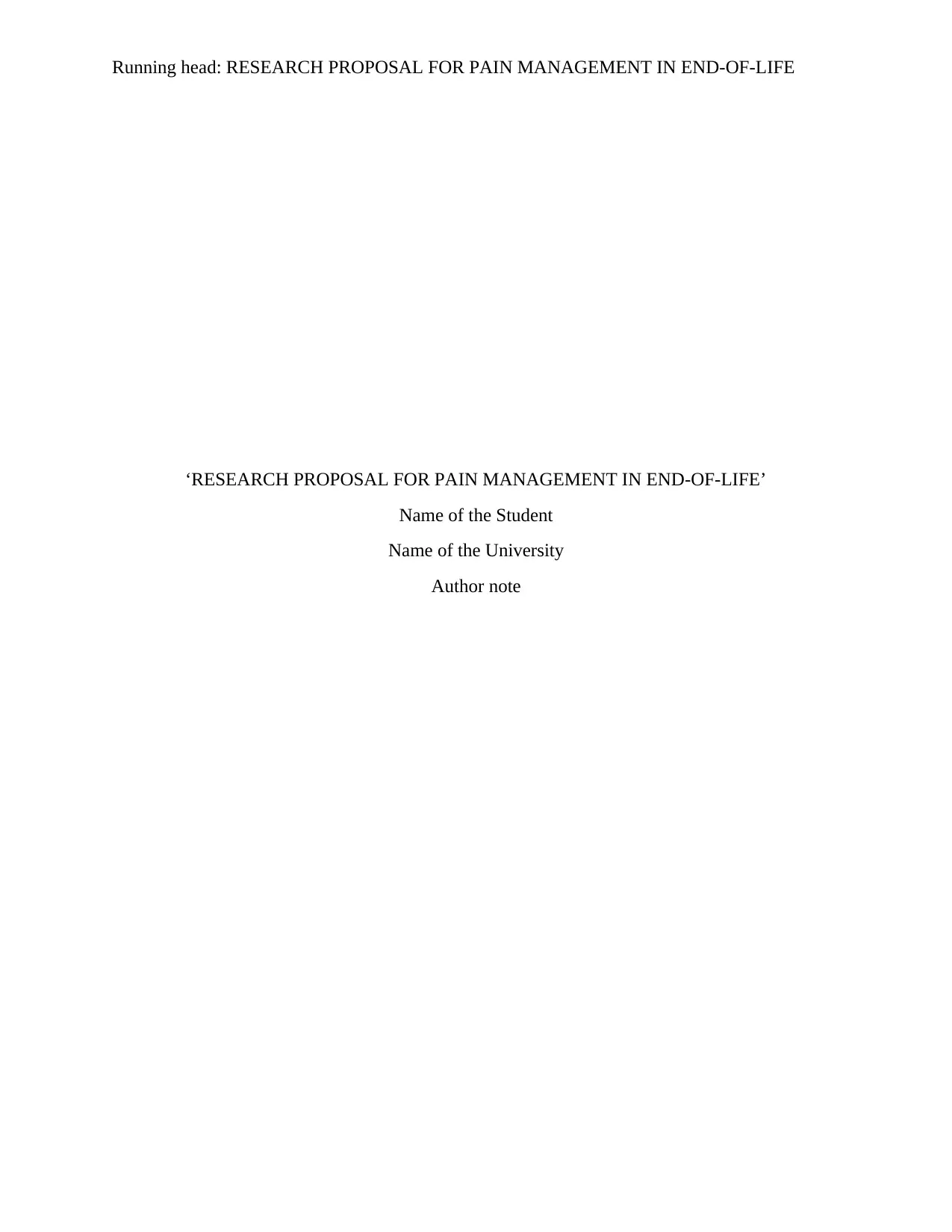
Running head: RESEARCH PROPOSAL FOR PAIN MANAGEMENT IN END-OF-LIFE
‘RESEARCH PROPOSAL FOR PAIN MANAGEMENT IN END-OF-LIFE’
Name of the Student
Name of the University
Author note
‘RESEARCH PROPOSAL FOR PAIN MANAGEMENT IN END-OF-LIFE’
Name of the Student
Name of the University
Author note
Secure Best Marks with AI Grader
Need help grading? Try our AI Grader for instant feedback on your assignments.
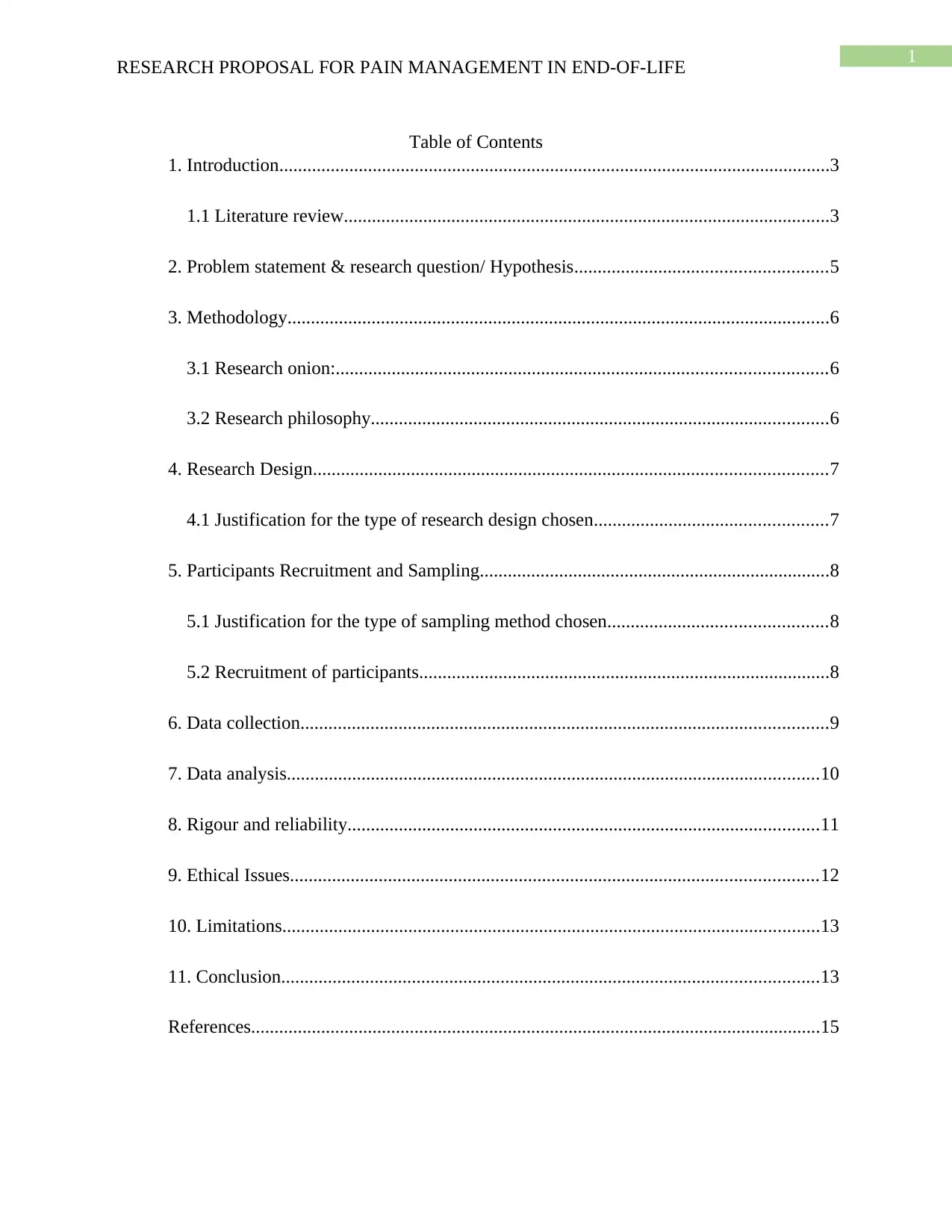
1
RESEARCH PROPOSAL FOR PAIN MANAGEMENT IN END-OF-LIFE
Table of Contents
1. Introduction......................................................................................................................3
1.1 Literature review........................................................................................................3
2. Problem statement & research question/ Hypothesis......................................................5
3. Methodology....................................................................................................................6
3.1 Research onion:.........................................................................................................6
3.2 Research philosophy..................................................................................................6
4. Research Design..............................................................................................................7
4.1 Justification for the type of research design chosen..................................................7
5. Participants Recruitment and Sampling...........................................................................8
5.1 Justification for the type of sampling method chosen...............................................8
5.2 Recruitment of participants........................................................................................8
6. Data collection.................................................................................................................9
7. Data analysis..................................................................................................................10
8. Rigour and reliability.....................................................................................................11
9. Ethical Issues.................................................................................................................12
10. Limitations...................................................................................................................13
11. Conclusion...................................................................................................................13
References..........................................................................................................................15
RESEARCH PROPOSAL FOR PAIN MANAGEMENT IN END-OF-LIFE
Table of Contents
1. Introduction......................................................................................................................3
1.1 Literature review........................................................................................................3
2. Problem statement & research question/ Hypothesis......................................................5
3. Methodology....................................................................................................................6
3.1 Research onion:.........................................................................................................6
3.2 Research philosophy..................................................................................................6
4. Research Design..............................................................................................................7
4.1 Justification for the type of research design chosen..................................................7
5. Participants Recruitment and Sampling...........................................................................8
5.1 Justification for the type of sampling method chosen...............................................8
5.2 Recruitment of participants........................................................................................8
6. Data collection.................................................................................................................9
7. Data analysis..................................................................................................................10
8. Rigour and reliability.....................................................................................................11
9. Ethical Issues.................................................................................................................12
10. Limitations...................................................................................................................13
11. Conclusion...................................................................................................................13
References..........................................................................................................................15

2
RESEARCH PROPOSAL FOR PAIN MANAGEMENT IN END-OF-LIFE
RESEARCH PROPOSAL FOR PAIN MANAGEMENT IN END-OF-LIFE

3
RESEARCH PROPOSAL FOR PAIN MANAGEMENT IN END-OF-LIFE
1. Introduction
According to the International Association for the Study of Pain (IASP), pain is defined
as an unpleasant sense or feeling due to potential tissue damage (Iasp-pain.org, 2017). Pain is not
just a physical condition; it is caused by personality, attitudes, and social beliefs and effect the
person’s emotional and mental health as well. There are different type of pains that affects
elderly people, at the end of their life. Acute, chronic, break through, bone related, nerve and
total pain are several kind of pains that affect people (Abdulla et al. 2013, p. 42). Therefore, pain
management of these elderly patients about to face the end of their life becomes important.
Priorities are to relief the symptoms of pain to make their end –life little relaxed. It also helps to
create a proper physician-patient relationship.
1.1 Literature review
There is a broad array of patients suffering from life threatening diseases such as cancer,
HIV and many more, which ultimately leads to end of life. These life-threatening diseases knows
no borders and affects rich, poor, young, old irrespective of race, gender and ethnicity. The
knowledge attitudes of nurses towards such patients in pain and their pain management strategies
has been studies by several researchers. According to Barry et al. (2012, p. 1260), nurses has the
central role in understanding and treating patients with dementia, where pain was prevalent
among older adults. The methodology they chose to find out the attitudes and knowledge of
nurses while providing care was random questionnaires comprising of six sections. These
questionnaires was sent to 244 nursing homes. After the data collection, it was seen that pain
management guideline strategies was not been followed by nearly 40 percent of nursing staffs.
The managers of those care centers were uncertain about managing the pain in residents. Usage
of opioid analgesic drugs was prevalent.
RESEARCH PROPOSAL FOR PAIN MANAGEMENT IN END-OF-LIFE
1. Introduction
According to the International Association for the Study of Pain (IASP), pain is defined
as an unpleasant sense or feeling due to potential tissue damage (Iasp-pain.org, 2017). Pain is not
just a physical condition; it is caused by personality, attitudes, and social beliefs and effect the
person’s emotional and mental health as well. There are different type of pains that affects
elderly people, at the end of their life. Acute, chronic, break through, bone related, nerve and
total pain are several kind of pains that affect people (Abdulla et al. 2013, p. 42). Therefore, pain
management of these elderly patients about to face the end of their life becomes important.
Priorities are to relief the symptoms of pain to make their end –life little relaxed. It also helps to
create a proper physician-patient relationship.
1.1 Literature review
There is a broad array of patients suffering from life threatening diseases such as cancer,
HIV and many more, which ultimately leads to end of life. These life-threatening diseases knows
no borders and affects rich, poor, young, old irrespective of race, gender and ethnicity. The
knowledge attitudes of nurses towards such patients in pain and their pain management strategies
has been studies by several researchers. According to Barry et al. (2012, p. 1260), nurses has the
central role in understanding and treating patients with dementia, where pain was prevalent
among older adults. The methodology they chose to find out the attitudes and knowledge of
nurses while providing care was random questionnaires comprising of six sections. These
questionnaires was sent to 244 nursing homes. After the data collection, it was seen that pain
management guideline strategies was not been followed by nearly 40 percent of nursing staffs.
The managers of those care centers were uncertain about managing the pain in residents. Usage
of opioid analgesic drugs was prevalent.
Secure Best Marks with AI Grader
Need help grading? Try our AI Grader for instant feedback on your assignments.
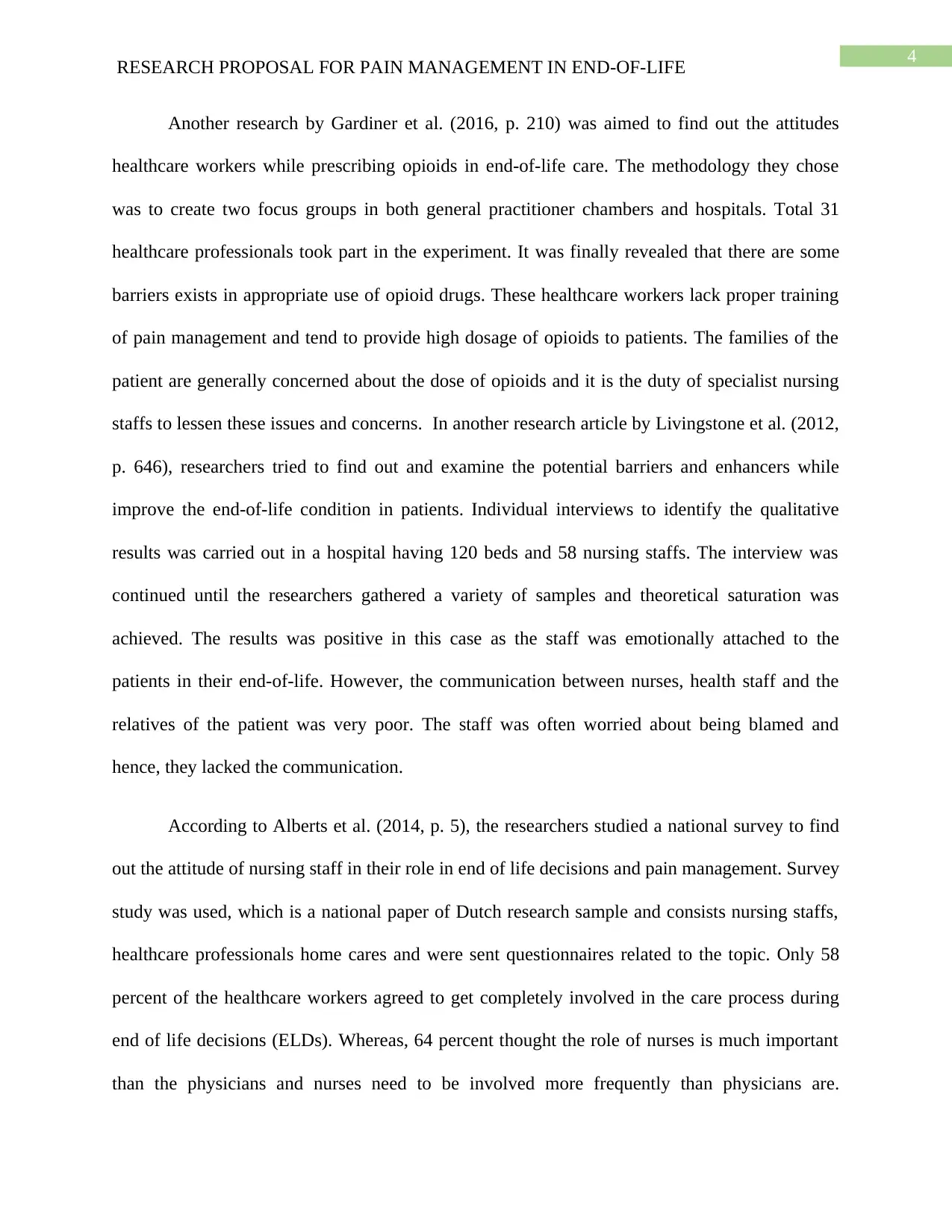
4
RESEARCH PROPOSAL FOR PAIN MANAGEMENT IN END-OF-LIFE
Another research by Gardiner et al. (2016, p. 210) was aimed to find out the attitudes
healthcare workers while prescribing opioids in end-of-life care. The methodology they chose
was to create two focus groups in both general practitioner chambers and hospitals. Total 31
healthcare professionals took part in the experiment. It was finally revealed that there are some
barriers exists in appropriate use of opioid drugs. These healthcare workers lack proper training
of pain management and tend to provide high dosage of opioids to patients. The families of the
patient are generally concerned about the dose of opioids and it is the duty of specialist nursing
staffs to lessen these issues and concerns. In another research article by Livingstone et al. (2012,
p. 646), researchers tried to find out and examine the potential barriers and enhancers while
improve the end-of-life condition in patients. Individual interviews to identify the qualitative
results was carried out in a hospital having 120 beds and 58 nursing staffs. The interview was
continued until the researchers gathered a variety of samples and theoretical saturation was
achieved. The results was positive in this case as the staff was emotionally attached to the
patients in their end-of-life. However, the communication between nurses, health staff and the
relatives of the patient was very poor. The staff was often worried about being blamed and
hence, they lacked the communication.
According to Alberts et al. (2014, p. 5), the researchers studied a national survey to find
out the attitude of nursing staff in their role in end of life decisions and pain management. Survey
study was used, which is a national paper of Dutch research sample and consists nursing staffs,
healthcare professionals home cares and were sent questionnaires related to the topic. Only 58
percent of the healthcare workers agreed to get completely involved in the care process during
end of life decisions (ELDs). Whereas, 64 percent thought the role of nurses is much important
than the physicians and nurses need to be involved more frequently than physicians are.
RESEARCH PROPOSAL FOR PAIN MANAGEMENT IN END-OF-LIFE
Another research by Gardiner et al. (2016, p. 210) was aimed to find out the attitudes
healthcare workers while prescribing opioids in end-of-life care. The methodology they chose
was to create two focus groups in both general practitioner chambers and hospitals. Total 31
healthcare professionals took part in the experiment. It was finally revealed that there are some
barriers exists in appropriate use of opioid drugs. These healthcare workers lack proper training
of pain management and tend to provide high dosage of opioids to patients. The families of the
patient are generally concerned about the dose of opioids and it is the duty of specialist nursing
staffs to lessen these issues and concerns. In another research article by Livingstone et al. (2012,
p. 646), researchers tried to find out and examine the potential barriers and enhancers while
improve the end-of-life condition in patients. Individual interviews to identify the qualitative
results was carried out in a hospital having 120 beds and 58 nursing staffs. The interview was
continued until the researchers gathered a variety of samples and theoretical saturation was
achieved. The results was positive in this case as the staff was emotionally attached to the
patients in their end-of-life. However, the communication between nurses, health staff and the
relatives of the patient was very poor. The staff was often worried about being blamed and
hence, they lacked the communication.
According to Alberts et al. (2014, p. 5), the researchers studied a national survey to find
out the attitude of nursing staff in their role in end of life decisions and pain management. Survey
study was used, which is a national paper of Dutch research sample and consists nursing staffs,
healthcare professionals home cares and were sent questionnaires related to the topic. Only 58
percent of the healthcare workers agreed to get completely involved in the care process during
end of life decisions (ELDs). Whereas, 64 percent thought the role of nurses is much important
than the physicians and nurses need to be involved more frequently than physicians are.
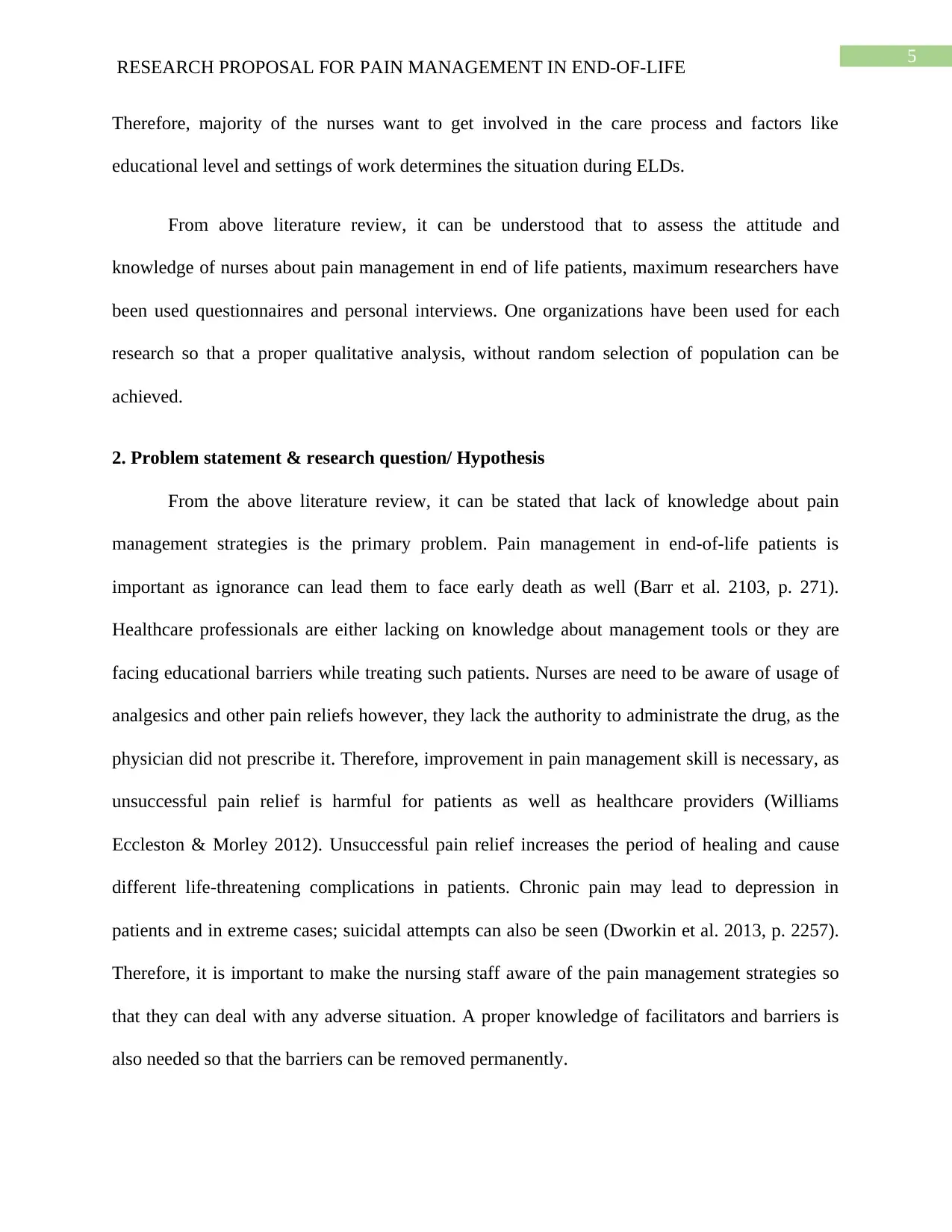
5
RESEARCH PROPOSAL FOR PAIN MANAGEMENT IN END-OF-LIFE
Therefore, majority of the nurses want to get involved in the care process and factors like
educational level and settings of work determines the situation during ELDs.
From above literature review, it can be understood that to assess the attitude and
knowledge of nurses about pain management in end of life patients, maximum researchers have
been used questionnaires and personal interviews. One organizations have been used for each
research so that a proper qualitative analysis, without random selection of population can be
achieved.
2. Problem statement & research question/ Hypothesis
From the above literature review, it can be stated that lack of knowledge about pain
management strategies is the primary problem. Pain management in end-of-life patients is
important as ignorance can lead them to face early death as well (Barr et al. 2103, p. 271).
Healthcare professionals are either lacking on knowledge about management tools or they are
facing educational barriers while treating such patients. Nurses are need to be aware of usage of
analgesics and other pain reliefs however, they lack the authority to administrate the drug, as the
physician did not prescribe it. Therefore, improvement in pain management skill is necessary, as
unsuccessful pain relief is harmful for patients as well as healthcare providers (Williams
Eccleston & Morley 2012). Unsuccessful pain relief increases the period of healing and cause
different life-threatening complications in patients. Chronic pain may lead to depression in
patients and in extreme cases; suicidal attempts can also be seen (Dworkin et al. 2013, p. 2257).
Therefore, it is important to make the nursing staff aware of the pain management strategies so
that they can deal with any adverse situation. A proper knowledge of facilitators and barriers is
also needed so that the barriers can be removed permanently.
RESEARCH PROPOSAL FOR PAIN MANAGEMENT IN END-OF-LIFE
Therefore, majority of the nurses want to get involved in the care process and factors like
educational level and settings of work determines the situation during ELDs.
From above literature review, it can be understood that to assess the attitude and
knowledge of nurses about pain management in end of life patients, maximum researchers have
been used questionnaires and personal interviews. One organizations have been used for each
research so that a proper qualitative analysis, without random selection of population can be
achieved.
2. Problem statement & research question/ Hypothesis
From the above literature review, it can be stated that lack of knowledge about pain
management strategies is the primary problem. Pain management in end-of-life patients is
important as ignorance can lead them to face early death as well (Barr et al. 2103, p. 271).
Healthcare professionals are either lacking on knowledge about management tools or they are
facing educational barriers while treating such patients. Nurses are need to be aware of usage of
analgesics and other pain reliefs however, they lack the authority to administrate the drug, as the
physician did not prescribe it. Therefore, improvement in pain management skill is necessary, as
unsuccessful pain relief is harmful for patients as well as healthcare providers (Williams
Eccleston & Morley 2012). Unsuccessful pain relief increases the period of healing and cause
different life-threatening complications in patients. Chronic pain may lead to depression in
patients and in extreme cases; suicidal attempts can also be seen (Dworkin et al. 2013, p. 2257).
Therefore, it is important to make the nursing staff aware of the pain management strategies so
that they can deal with any adverse situation. A proper knowledge of facilitators and barriers is
also needed so that the barriers can be removed permanently.

6
RESEARCH PROPOSAL FOR PAIN MANAGEMENT IN END-OF-LIFE
Furthermore, the aim of this research is to understand the attitudes and knowledge of
such nurses related to pain management strategies. The research question is ‘what are the
attitudes of nursing staff towards pain management during the end of life?’ the purpose of this
research proposal to figure out the strategies to improve pain management and to carry out the
need assessment to keep up with the strategies.
3. Methodology
A qualitative methodology can be designed to describe the study. Interviews can be
conducted and those in-depth interviews can be of semi-structured (Liamputtong 2013). The
researcher should keep a track of these interviews so that it is easier for him/her to interpret the
data. The researcher also relied on the reliability and ethics at the time of performing the
research. Such research method allow the researcher to study the research in suitable manner as it
deals with the technical or logical ways (Marshall & Rossman 2014).
3.1 Research onion:
Research onion is an important step for research methodology as it explains the each
layer of research design. Research onion is generally comprised of many layers and every layer
consists steps that need to be followed one after another (Johnston 2014, p. 210). It provides the
researcher a methodological structure depending on which systematic review is done. However,
there are researchers who do not agree that research onion is simple process and helpful to carry
out qualitative research, unfolding each layer of it.
3.2 Research philosophy
Research philosophy helps the researcher to find out a relevant and essential knowledge
about the research. There are generally four types of research philosophy, such as positivism,
RESEARCH PROPOSAL FOR PAIN MANAGEMENT IN END-OF-LIFE
Furthermore, the aim of this research is to understand the attitudes and knowledge of
such nurses related to pain management strategies. The research question is ‘what are the
attitudes of nursing staff towards pain management during the end of life?’ the purpose of this
research proposal to figure out the strategies to improve pain management and to carry out the
need assessment to keep up with the strategies.
3. Methodology
A qualitative methodology can be designed to describe the study. Interviews can be
conducted and those in-depth interviews can be of semi-structured (Liamputtong 2013). The
researcher should keep a track of these interviews so that it is easier for him/her to interpret the
data. The researcher also relied on the reliability and ethics at the time of performing the
research. Such research method allow the researcher to study the research in suitable manner as it
deals with the technical or logical ways (Marshall & Rossman 2014).
3.1 Research onion:
Research onion is an important step for research methodology as it explains the each
layer of research design. Research onion is generally comprised of many layers and every layer
consists steps that need to be followed one after another (Johnston 2014, p. 210). It provides the
researcher a methodological structure depending on which systematic review is done. However,
there are researchers who do not agree that research onion is simple process and helpful to carry
out qualitative research, unfolding each layer of it.
3.2 Research philosophy
Research philosophy helps the researcher to find out a relevant and essential knowledge
about the research. There are generally four types of research philosophy, such as positivism,
Paraphrase This Document
Need a fresh take? Get an instant paraphrase of this document with our AI Paraphraser
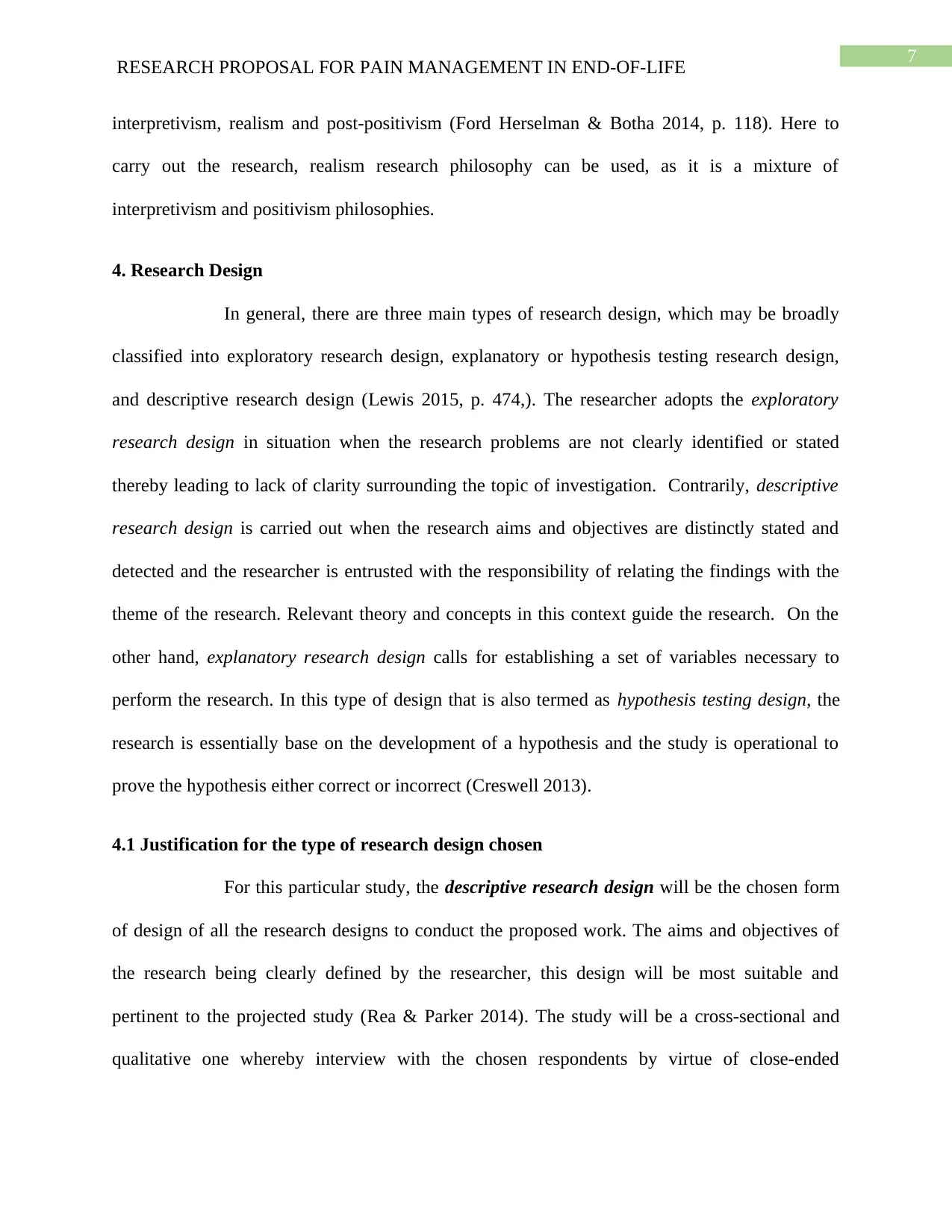
7
RESEARCH PROPOSAL FOR PAIN MANAGEMENT IN END-OF-LIFE
interpretivism, realism and post-positivism (Ford Herselman & Botha 2014, p. 118). Here to
carry out the research, realism research philosophy can be used, as it is a mixture of
interpretivism and positivism philosophies.
4. Research Design
In general, there are three main types of research design, which may be broadly
classified into exploratory research design, explanatory or hypothesis testing research design,
and descriptive research design (Lewis 2015, p. 474,). The researcher adopts the exploratory
research design in situation when the research problems are not clearly identified or stated
thereby leading to lack of clarity surrounding the topic of investigation. Contrarily, descriptive
research design is carried out when the research aims and objectives are distinctly stated and
detected and the researcher is entrusted with the responsibility of relating the findings with the
theme of the research. Relevant theory and concepts in this context guide the research. On the
other hand, explanatory research design calls for establishing a set of variables necessary to
perform the research. In this type of design that is also termed as hypothesis testing design, the
research is essentially base on the development of a hypothesis and the study is operational to
prove the hypothesis either correct or incorrect (Creswell 2013).
4.1 Justification for the type of research design chosen
For this particular study, the descriptive research design will be the chosen form
of design of all the research designs to conduct the proposed work. The aims and objectives of
the research being clearly defined by the researcher, this design will be most suitable and
pertinent to the projected study (Rea & Parker 2014). The study will be a cross-sectional and
qualitative one whereby interview with the chosen respondents by virtue of close-ended
RESEARCH PROPOSAL FOR PAIN MANAGEMENT IN END-OF-LIFE
interpretivism, realism and post-positivism (Ford Herselman & Botha 2014, p. 118). Here to
carry out the research, realism research philosophy can be used, as it is a mixture of
interpretivism and positivism philosophies.
4. Research Design
In general, there are three main types of research design, which may be broadly
classified into exploratory research design, explanatory or hypothesis testing research design,
and descriptive research design (Lewis 2015, p. 474,). The researcher adopts the exploratory
research design in situation when the research problems are not clearly identified or stated
thereby leading to lack of clarity surrounding the topic of investigation. Contrarily, descriptive
research design is carried out when the research aims and objectives are distinctly stated and
detected and the researcher is entrusted with the responsibility of relating the findings with the
theme of the research. Relevant theory and concepts in this context guide the research. On the
other hand, explanatory research design calls for establishing a set of variables necessary to
perform the research. In this type of design that is also termed as hypothesis testing design, the
research is essentially base on the development of a hypothesis and the study is operational to
prove the hypothesis either correct or incorrect (Creswell 2013).
4.1 Justification for the type of research design chosen
For this particular study, the descriptive research design will be the chosen form
of design of all the research designs to conduct the proposed work. The aims and objectives of
the research being clearly defined by the researcher, this design will be most suitable and
pertinent to the projected study (Rea & Parker 2014). The study will be a cross-sectional and
qualitative one whereby interview with the chosen respondents by virtue of close-ended

8
RESEARCH PROPOSAL FOR PAIN MANAGEMENT IN END-OF-LIFE
questionnaire will aid in emanation of definite themes for clearly elucidating the chosen topic of
research.
RESEARCH PROPOSAL FOR PAIN MANAGEMENT IN END-OF-LIFE
questionnaire will aid in emanation of definite themes for clearly elucidating the chosen topic of
research.
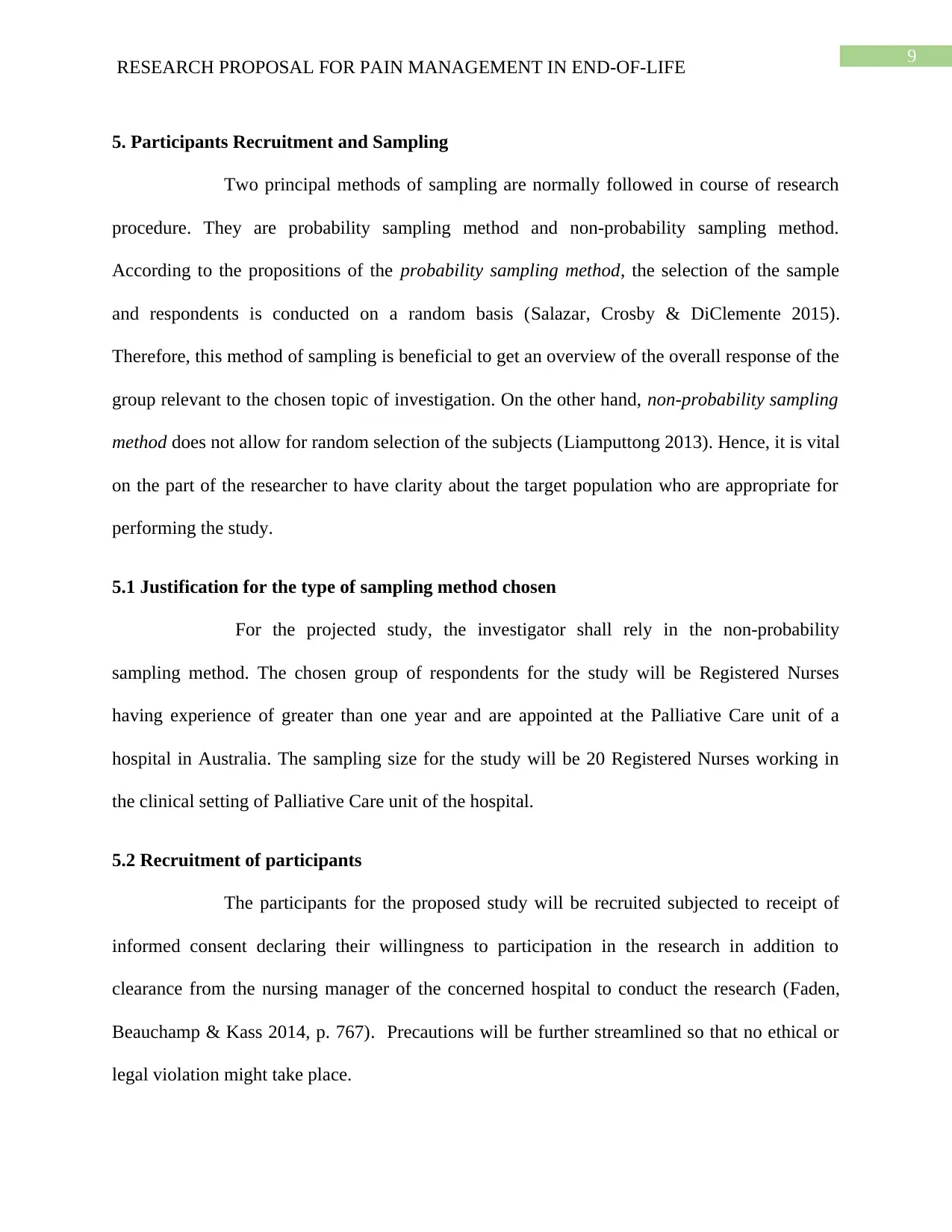
9
RESEARCH PROPOSAL FOR PAIN MANAGEMENT IN END-OF-LIFE
5. Participants Recruitment and Sampling
Two principal methods of sampling are normally followed in course of research
procedure. They are probability sampling method and non-probability sampling method.
According to the propositions of the probability sampling method, the selection of the sample
and respondents is conducted on a random basis (Salazar, Crosby & DiClemente 2015).
Therefore, this method of sampling is beneficial to get an overview of the overall response of the
group relevant to the chosen topic of investigation. On the other hand, non-probability sampling
method does not allow for random selection of the subjects (Liamputtong 2013). Hence, it is vital
on the part of the researcher to have clarity about the target population who are appropriate for
performing the study.
5.1 Justification for the type of sampling method chosen
For the projected study, the investigator shall rely in the non-probability
sampling method. The chosen group of respondents for the study will be Registered Nurses
having experience of greater than one year and are appointed at the Palliative Care unit of a
hospital in Australia. The sampling size for the study will be 20 Registered Nurses working in
the clinical setting of Palliative Care unit of the hospital.
5.2 Recruitment of participants
The participants for the proposed study will be recruited subjected to receipt of
informed consent declaring their willingness to participation in the research in addition to
clearance from the nursing manager of the concerned hospital to conduct the research (Faden,
Beauchamp & Kass 2014, p. 767). Precautions will be further streamlined so that no ethical or
legal violation might take place.
RESEARCH PROPOSAL FOR PAIN MANAGEMENT IN END-OF-LIFE
5. Participants Recruitment and Sampling
Two principal methods of sampling are normally followed in course of research
procedure. They are probability sampling method and non-probability sampling method.
According to the propositions of the probability sampling method, the selection of the sample
and respondents is conducted on a random basis (Salazar, Crosby & DiClemente 2015).
Therefore, this method of sampling is beneficial to get an overview of the overall response of the
group relevant to the chosen topic of investigation. On the other hand, non-probability sampling
method does not allow for random selection of the subjects (Liamputtong 2013). Hence, it is vital
on the part of the researcher to have clarity about the target population who are appropriate for
performing the study.
5.1 Justification for the type of sampling method chosen
For the projected study, the investigator shall rely in the non-probability
sampling method. The chosen group of respondents for the study will be Registered Nurses
having experience of greater than one year and are appointed at the Palliative Care unit of a
hospital in Australia. The sampling size for the study will be 20 Registered Nurses working in
the clinical setting of Palliative Care unit of the hospital.
5.2 Recruitment of participants
The participants for the proposed study will be recruited subjected to receipt of
informed consent declaring their willingness to participation in the research in addition to
clearance from the nursing manager of the concerned hospital to conduct the research (Faden,
Beauchamp & Kass 2014, p. 767). Precautions will be further streamlined so that no ethical or
legal violation might take place.
Secure Best Marks with AI Grader
Need help grading? Try our AI Grader for instant feedback on your assignments.
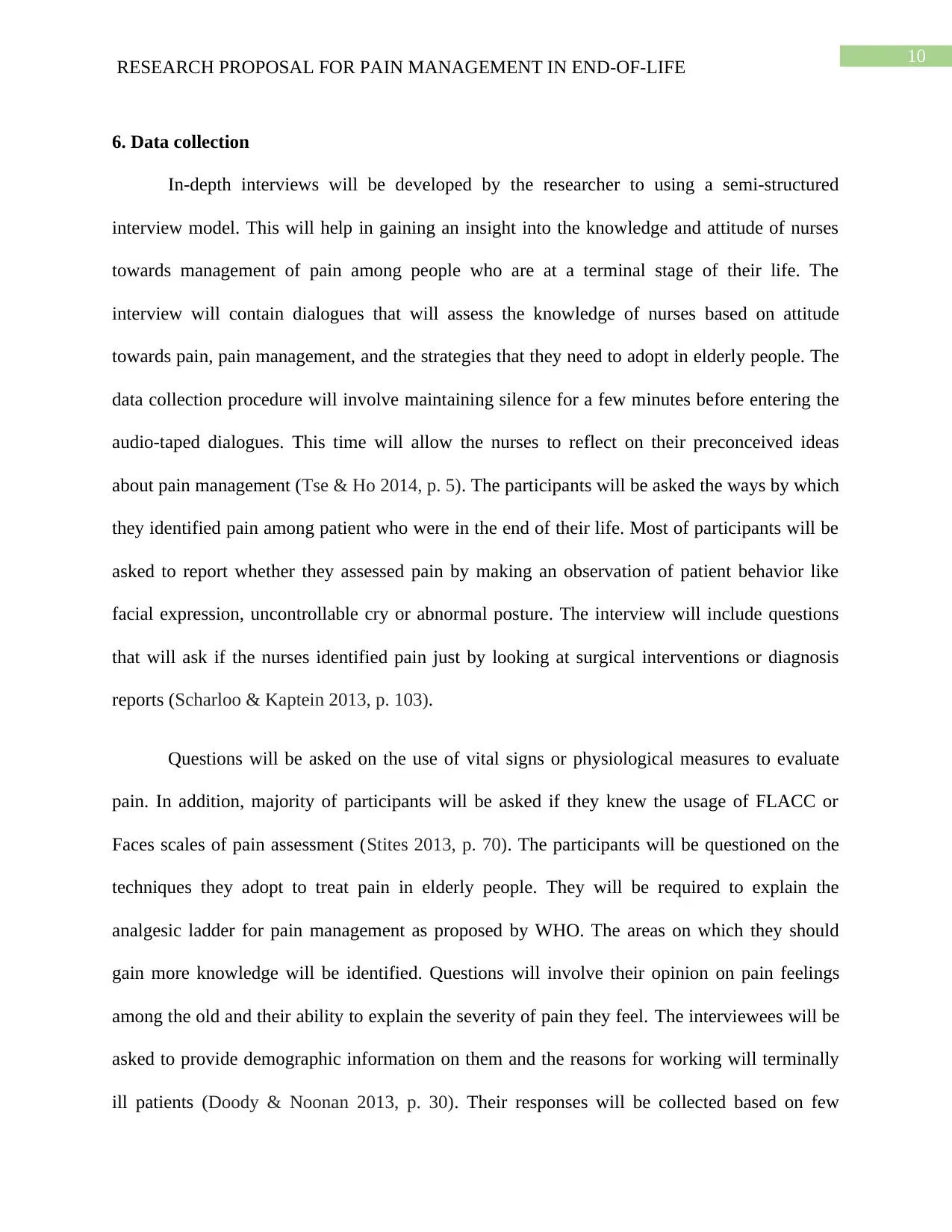
10
RESEARCH PROPOSAL FOR PAIN MANAGEMENT IN END-OF-LIFE
6. Data collection
In-depth interviews will be developed by the researcher to using a semi-structured
interview model. This will help in gaining an insight into the knowledge and attitude of nurses
towards management of pain among people who are at a terminal stage of their life. The
interview will contain dialogues that will assess the knowledge of nurses based on attitude
towards pain, pain management, and the strategies that they need to adopt in elderly people. The
data collection procedure will involve maintaining silence for a few minutes before entering the
audio-taped dialogues. This time will allow the nurses to reflect on their preconceived ideas
about pain management (Tse & Ho 2014, p. 5). The participants will be asked the ways by which
they identified pain among patient who were in the end of their life. Most of participants will be
asked to report whether they assessed pain by making an observation of patient behavior like
facial expression, uncontrollable cry or abnormal posture. The interview will include questions
that will ask if the nurses identified pain just by looking at surgical interventions or diagnosis
reports (Scharloo & Kaptein 2013, p. 103).
Questions will be asked on the use of vital signs or physiological measures to evaluate
pain. In addition, majority of participants will be asked if they knew the usage of FLACC or
Faces scales of pain assessment (Stites 2013, p. 70). The participants will be questioned on the
techniques they adopt to treat pain in elderly people. They will be required to explain the
analgesic ladder for pain management as proposed by WHO. The areas on which they should
gain more knowledge will be identified. Questions will involve their opinion on pain feelings
among the old and their ability to explain the severity of pain they feel. The interviewees will be
asked to provide demographic information on them and the reasons for working will terminally
ill patients (Doody & Noonan 2013, p. 30). Their responses will be collected based on few
RESEARCH PROPOSAL FOR PAIN MANAGEMENT IN END-OF-LIFE
6. Data collection
In-depth interviews will be developed by the researcher to using a semi-structured
interview model. This will help in gaining an insight into the knowledge and attitude of nurses
towards management of pain among people who are at a terminal stage of their life. The
interview will contain dialogues that will assess the knowledge of nurses based on attitude
towards pain, pain management, and the strategies that they need to adopt in elderly people. The
data collection procedure will involve maintaining silence for a few minutes before entering the
audio-taped dialogues. This time will allow the nurses to reflect on their preconceived ideas
about pain management (Tse & Ho 2014, p. 5). The participants will be asked the ways by which
they identified pain among patient who were in the end of their life. Most of participants will be
asked to report whether they assessed pain by making an observation of patient behavior like
facial expression, uncontrollable cry or abnormal posture. The interview will include questions
that will ask if the nurses identified pain just by looking at surgical interventions or diagnosis
reports (Scharloo & Kaptein 2013, p. 103).
Questions will be asked on the use of vital signs or physiological measures to evaluate
pain. In addition, majority of participants will be asked if they knew the usage of FLACC or
Faces scales of pain assessment (Stites 2013, p. 70). The participants will be questioned on the
techniques they adopt to treat pain in elderly people. They will be required to explain the
analgesic ladder for pain management as proposed by WHO. The areas on which they should
gain more knowledge will be identified. Questions will involve their opinion on pain feelings
among the old and their ability to explain the severity of pain they feel. The interviewees will be
asked to provide demographic information on them and the reasons for working will terminally
ill patients (Doody & Noonan 2013, p. 30). Their responses will be collected based on few
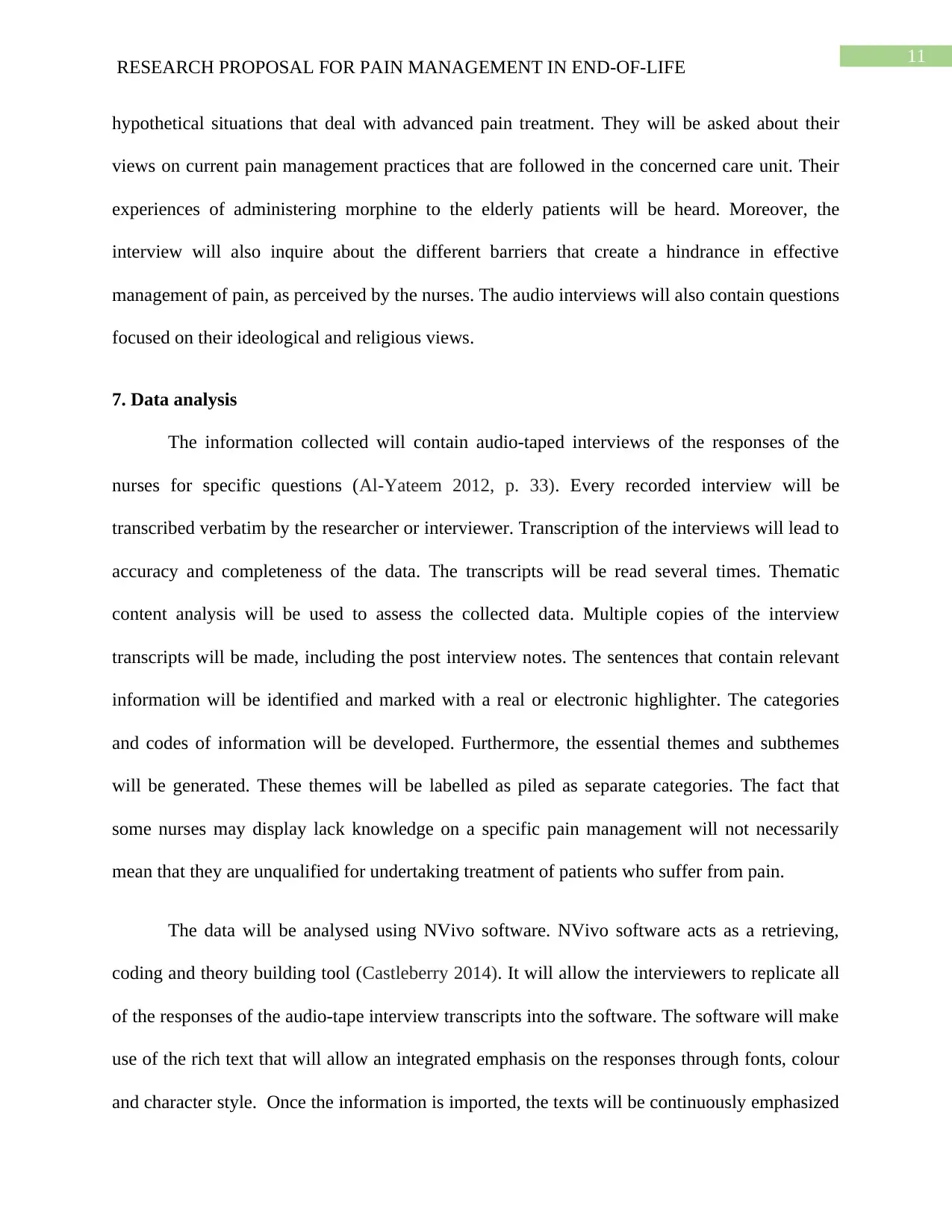
11
RESEARCH PROPOSAL FOR PAIN MANAGEMENT IN END-OF-LIFE
hypothetical situations that deal with advanced pain treatment. They will be asked about their
views on current pain management practices that are followed in the concerned care unit. Their
experiences of administering morphine to the elderly patients will be heard. Moreover, the
interview will also inquire about the different barriers that create a hindrance in effective
management of pain, as perceived by the nurses. The audio interviews will also contain questions
focused on their ideological and religious views.
7. Data analysis
The information collected will contain audio-taped interviews of the responses of the
nurses for specific questions (Al-Yateem 2012, p. 33). Every recorded interview will be
transcribed verbatim by the researcher or interviewer. Transcription of the interviews will lead to
accuracy and completeness of the data. The transcripts will be read several times. Thematic
content analysis will be used to assess the collected data. Multiple copies of the interview
transcripts will be made, including the post interview notes. The sentences that contain relevant
information will be identified and marked with a real or electronic highlighter. The categories
and codes of information will be developed. Furthermore, the essential themes and subthemes
will be generated. These themes will be labelled as piled as separate categories. The fact that
some nurses may display lack knowledge on a specific pain management will not necessarily
mean that they are unqualified for undertaking treatment of patients who suffer from pain.
The data will be analysed using NVivo software. NVivo software acts as a retrieving,
coding and theory building tool (Castleberry 2014). It will allow the interviewers to replicate all
of the responses of the audio-tape interview transcripts into the software. The software will make
use of the rich text that will allow an integrated emphasis on the responses through fonts, colour
and character style. Once the information is imported, the texts will be continuously emphasized
RESEARCH PROPOSAL FOR PAIN MANAGEMENT IN END-OF-LIFE
hypothetical situations that deal with advanced pain treatment. They will be asked about their
views on current pain management practices that are followed in the concerned care unit. Their
experiences of administering morphine to the elderly patients will be heard. Moreover, the
interview will also inquire about the different barriers that create a hindrance in effective
management of pain, as perceived by the nurses. The audio interviews will also contain questions
focused on their ideological and religious views.
7. Data analysis
The information collected will contain audio-taped interviews of the responses of the
nurses for specific questions (Al-Yateem 2012, p. 33). Every recorded interview will be
transcribed verbatim by the researcher or interviewer. Transcription of the interviews will lead to
accuracy and completeness of the data. The transcripts will be read several times. Thematic
content analysis will be used to assess the collected data. Multiple copies of the interview
transcripts will be made, including the post interview notes. The sentences that contain relevant
information will be identified and marked with a real or electronic highlighter. The categories
and codes of information will be developed. Furthermore, the essential themes and subthemes
will be generated. These themes will be labelled as piled as separate categories. The fact that
some nurses may display lack knowledge on a specific pain management will not necessarily
mean that they are unqualified for undertaking treatment of patients who suffer from pain.
The data will be analysed using NVivo software. NVivo software acts as a retrieving,
coding and theory building tool (Castleberry 2014). It will allow the interviewers to replicate all
of the responses of the audio-tape interview transcripts into the software. The software will make
use of the rich text that will allow an integrated emphasis on the responses through fonts, colour
and character style. Once the information is imported, the texts will be continuously emphasized
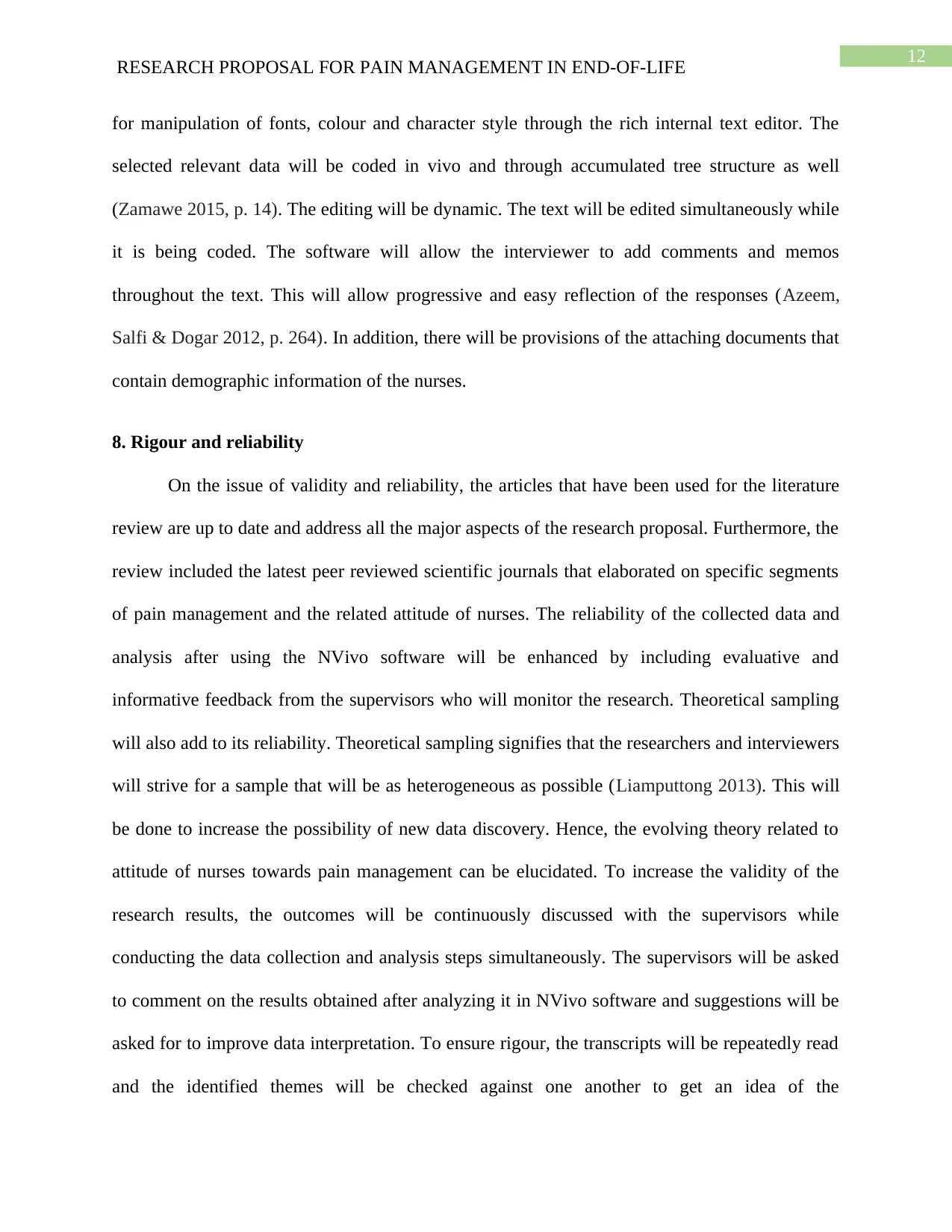
12
RESEARCH PROPOSAL FOR PAIN MANAGEMENT IN END-OF-LIFE
for manipulation of fonts, colour and character style through the rich internal text editor. The
selected relevant data will be coded in vivo and through accumulated tree structure as well
(Zamawe 2015, p. 14). The editing will be dynamic. The text will be edited simultaneously while
it is being coded. The software will allow the interviewer to add comments and memos
throughout the text. This will allow progressive and easy reflection of the responses (Azeem,
Salfi & Dogar 2012, p. 264). In addition, there will be provisions of the attaching documents that
contain demographic information of the nurses.
8. Rigour and reliability
On the issue of validity and reliability, the articles that have been used for the literature
review are up to date and address all the major aspects of the research proposal. Furthermore, the
review included the latest peer reviewed scientific journals that elaborated on specific segments
of pain management and the related attitude of nurses. The reliability of the collected data and
analysis after using the NVivo software will be enhanced by including evaluative and
informative feedback from the supervisors who will monitor the research. Theoretical sampling
will also add to its reliability. Theoretical sampling signifies that the researchers and interviewers
will strive for a sample that will be as heterogeneous as possible (Liamputtong 2013). This will
be done to increase the possibility of new data discovery. Hence, the evolving theory related to
attitude of nurses towards pain management can be elucidated. To increase the validity of the
research results, the outcomes will be continuously discussed with the supervisors while
conducting the data collection and analysis steps simultaneously. The supervisors will be asked
to comment on the results obtained after analyzing it in NVivo software and suggestions will be
asked for to improve data interpretation. To ensure rigour, the transcripts will be repeatedly read
and the identified themes will be checked against one another to get an idea of the
RESEARCH PROPOSAL FOR PAIN MANAGEMENT IN END-OF-LIFE
for manipulation of fonts, colour and character style through the rich internal text editor. The
selected relevant data will be coded in vivo and through accumulated tree structure as well
(Zamawe 2015, p. 14). The editing will be dynamic. The text will be edited simultaneously while
it is being coded. The software will allow the interviewer to add comments and memos
throughout the text. This will allow progressive and easy reflection of the responses (Azeem,
Salfi & Dogar 2012, p. 264). In addition, there will be provisions of the attaching documents that
contain demographic information of the nurses.
8. Rigour and reliability
On the issue of validity and reliability, the articles that have been used for the literature
review are up to date and address all the major aspects of the research proposal. Furthermore, the
review included the latest peer reviewed scientific journals that elaborated on specific segments
of pain management and the related attitude of nurses. The reliability of the collected data and
analysis after using the NVivo software will be enhanced by including evaluative and
informative feedback from the supervisors who will monitor the research. Theoretical sampling
will also add to its reliability. Theoretical sampling signifies that the researchers and interviewers
will strive for a sample that will be as heterogeneous as possible (Liamputtong 2013). This will
be done to increase the possibility of new data discovery. Hence, the evolving theory related to
attitude of nurses towards pain management can be elucidated. To increase the validity of the
research results, the outcomes will be continuously discussed with the supervisors while
conducting the data collection and analysis steps simultaneously. The supervisors will be asked
to comment on the results obtained after analyzing it in NVivo software and suggestions will be
asked for to improve data interpretation. To ensure rigour, the transcripts will be repeatedly read
and the identified themes will be checked against one another to get an idea of the
Paraphrase This Document
Need a fresh take? Get an instant paraphrase of this document with our AI Paraphraser
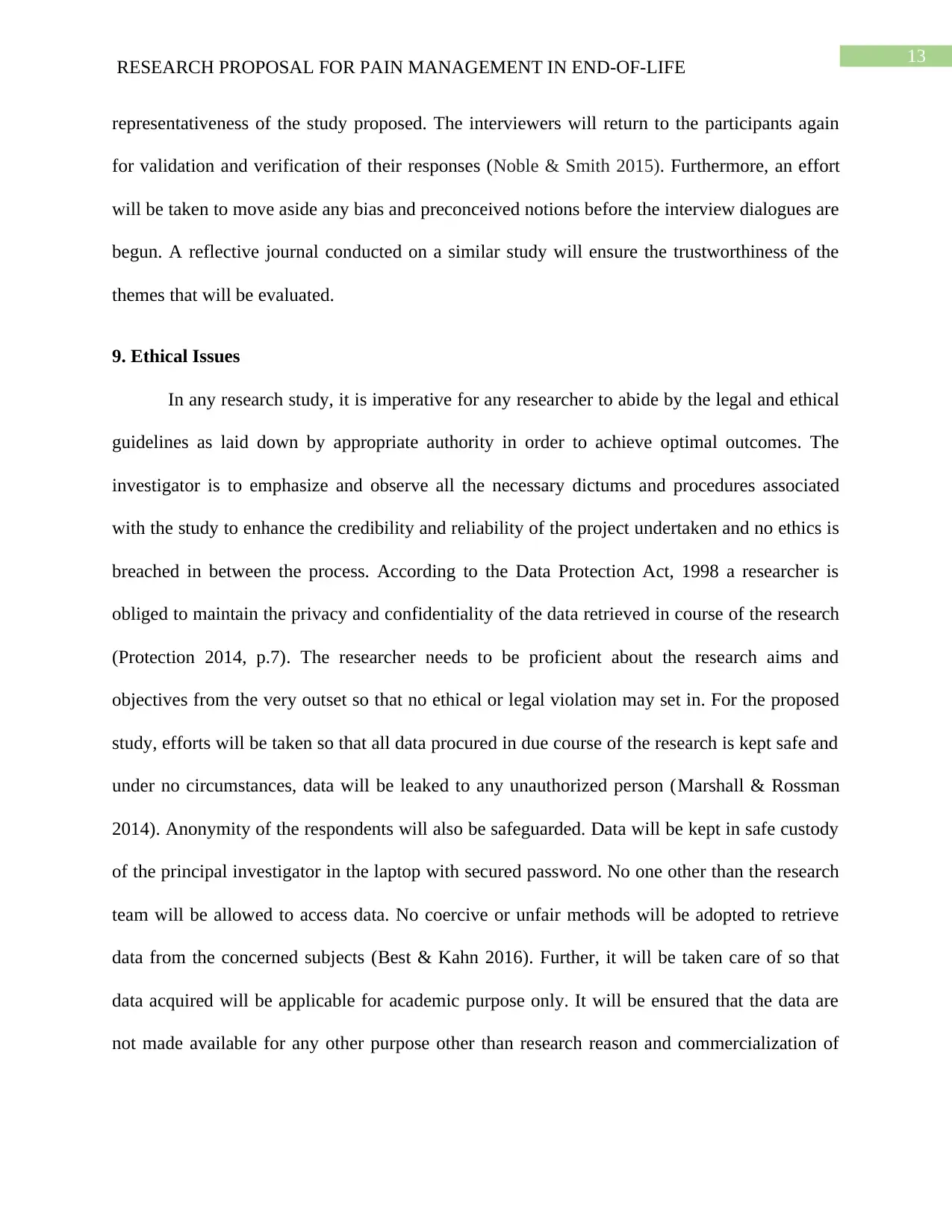
13
RESEARCH PROPOSAL FOR PAIN MANAGEMENT IN END-OF-LIFE
representativeness of the study proposed. The interviewers will return to the participants again
for validation and verification of their responses (Noble & Smith 2015). Furthermore, an effort
will be taken to move aside any bias and preconceived notions before the interview dialogues are
begun. A reflective journal conducted on a similar study will ensure the trustworthiness of the
themes that will be evaluated.
9. Ethical Issues
In any research study, it is imperative for any researcher to abide by the legal and ethical
guidelines as laid down by appropriate authority in order to achieve optimal outcomes. The
investigator is to emphasize and observe all the necessary dictums and procedures associated
with the study to enhance the credibility and reliability of the project undertaken and no ethics is
breached in between the process. According to the Data Protection Act, 1998 a researcher is
obliged to maintain the privacy and confidentiality of the data retrieved in course of the research
(Protection 2014, p.7). The researcher needs to be proficient about the research aims and
objectives from the very outset so that no ethical or legal violation may set in. For the proposed
study, efforts will be taken so that all data procured in due course of the research is kept safe and
under no circumstances, data will be leaked to any unauthorized person (Marshall & Rossman
2014). Anonymity of the respondents will also be safeguarded. Data will be kept in safe custody
of the principal investigator in the laptop with secured password. No one other than the research
team will be allowed to access data. No coercive or unfair methods will be adopted to retrieve
data from the concerned subjects (Best & Kahn 2016). Further, it will be taken care of so that
data acquired will be applicable for academic purpose only. It will be ensured that the data are
not made available for any other purpose other than research reason and commercialization of
RESEARCH PROPOSAL FOR PAIN MANAGEMENT IN END-OF-LIFE
representativeness of the study proposed. The interviewers will return to the participants again
for validation and verification of their responses (Noble & Smith 2015). Furthermore, an effort
will be taken to move aside any bias and preconceived notions before the interview dialogues are
begun. A reflective journal conducted on a similar study will ensure the trustworthiness of the
themes that will be evaluated.
9. Ethical Issues
In any research study, it is imperative for any researcher to abide by the legal and ethical
guidelines as laid down by appropriate authority in order to achieve optimal outcomes. The
investigator is to emphasize and observe all the necessary dictums and procedures associated
with the study to enhance the credibility and reliability of the project undertaken and no ethics is
breached in between the process. According to the Data Protection Act, 1998 a researcher is
obliged to maintain the privacy and confidentiality of the data retrieved in course of the research
(Protection 2014, p.7). The researcher needs to be proficient about the research aims and
objectives from the very outset so that no ethical or legal violation may set in. For the proposed
study, efforts will be taken so that all data procured in due course of the research is kept safe and
under no circumstances, data will be leaked to any unauthorized person (Marshall & Rossman
2014). Anonymity of the respondents will also be safeguarded. Data will be kept in safe custody
of the principal investigator in the laptop with secured password. No one other than the research
team will be allowed to access data. No coercive or unfair methods will be adopted to retrieve
data from the concerned subjects (Best & Kahn 2016). Further, it will be taken care of so that
data acquired will be applicable for academic purpose only. It will be ensured that the data are
not made available for any other purpose other than research reason and commercialization of

14
RESEARCH PROPOSAL FOR PAIN MANAGEMENT IN END-OF-LIFE
data will be prevented. All the governing standards and legislations will be diligently followed in
the study.
10. Limitations
The study provides a holistic way to analyze the condition compared to any other studies
that focuses on single factors of pain management. However, these methods can lead to
superficial side of research focusing on every mater, making it complex and vague. The findings
of this research are completely dependent on the research sampling. Therefore, possibility of
nurses having thorough knowledge of pain management strategies are out of the research can
also occur. Therefore, research results having data from novice nurses cannot determine the
success or failure of research. Small sample population can be another major limitation where
only 20 nurses are being involved. Inclusion and exclusion criteria for those participant nurses
also can be reason to get limited results. Conducting structured interviews in only two
organizations are limiting as well as it does not defines the trend or knowledge of a pool of
healthcare worker working in close vicinities. Lack of targeted questions to assess the attitude
and knowledge of nurses can also lead to restricted findings.
11. Conclusion
To conclude the research proposal, it can be said that nurses have proper knowledge
about pain management and its treatment, however there are major gaps that exists. Educational
level and work culture does not allow them to use their methods to treat patients in pain.
Moreover, there are some negative attitudes that are prevalent certainly in the treatment of
RESEARCH PROPOSAL FOR PAIN MANAGEMENT IN END-OF-LIFE
data will be prevented. All the governing standards and legislations will be diligently followed in
the study.
10. Limitations
The study provides a holistic way to analyze the condition compared to any other studies
that focuses on single factors of pain management. However, these methods can lead to
superficial side of research focusing on every mater, making it complex and vague. The findings
of this research are completely dependent on the research sampling. Therefore, possibility of
nurses having thorough knowledge of pain management strategies are out of the research can
also occur. Therefore, research results having data from novice nurses cannot determine the
success or failure of research. Small sample population can be another major limitation where
only 20 nurses are being involved. Inclusion and exclusion criteria for those participant nurses
also can be reason to get limited results. Conducting structured interviews in only two
organizations are limiting as well as it does not defines the trend or knowledge of a pool of
healthcare worker working in close vicinities. Lack of targeted questions to assess the attitude
and knowledge of nurses can also lead to restricted findings.
11. Conclusion
To conclude the research proposal, it can be said that nurses have proper knowledge
about pain management and its treatment, however there are major gaps that exists. Educational
level and work culture does not allow them to use their methods to treat patients in pain.
Moreover, there are some negative attitudes that are prevalent certainly in the treatment of
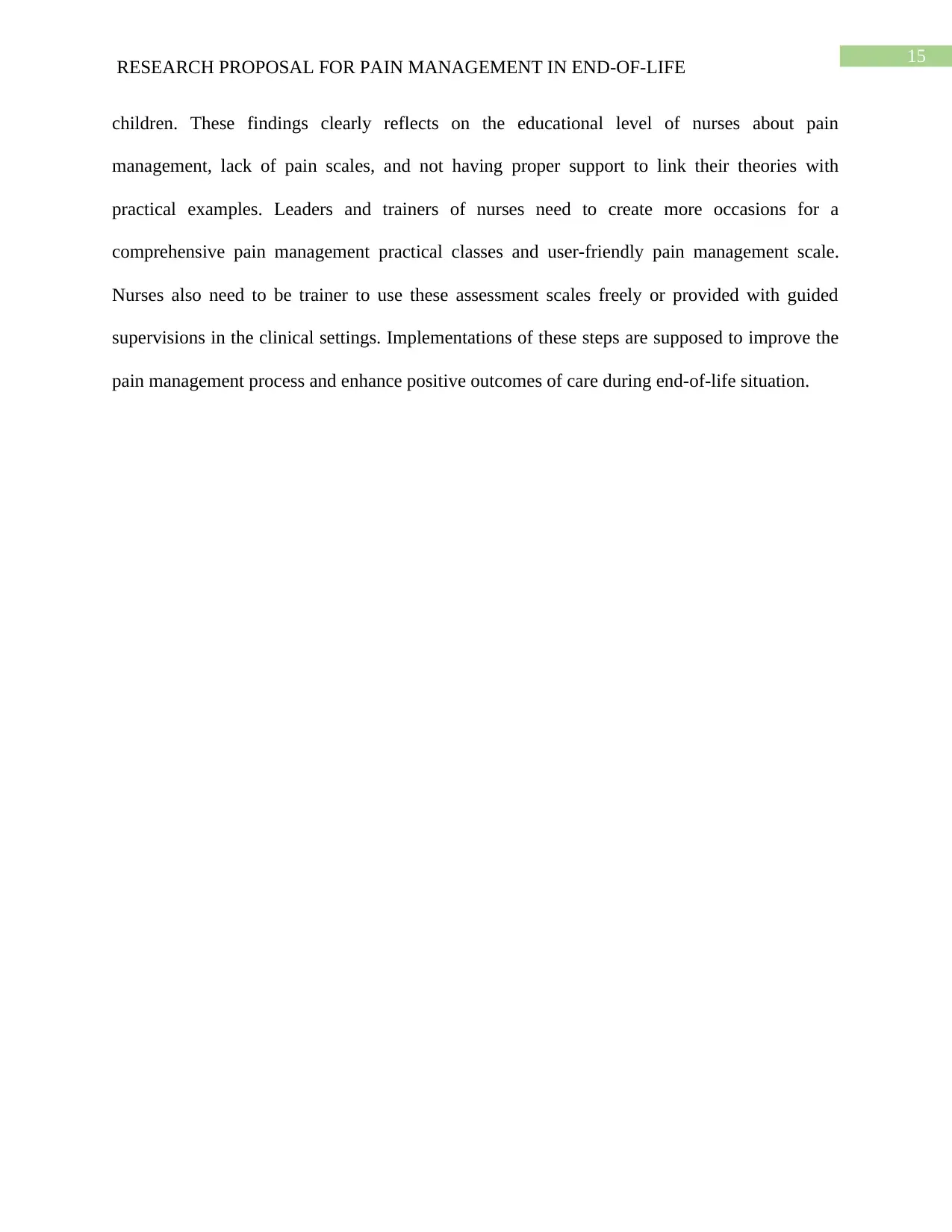
15
RESEARCH PROPOSAL FOR PAIN MANAGEMENT IN END-OF-LIFE
children. These findings clearly reflects on the educational level of nurses about pain
management, lack of pain scales, and not having proper support to link their theories with
practical examples. Leaders and trainers of nurses need to create more occasions for a
comprehensive pain management practical classes and user-friendly pain management scale.
Nurses also need to be trainer to use these assessment scales freely or provided with guided
supervisions in the clinical settings. Implementations of these steps are supposed to improve the
pain management process and enhance positive outcomes of care during end-of-life situation.
RESEARCH PROPOSAL FOR PAIN MANAGEMENT IN END-OF-LIFE
children. These findings clearly reflects on the educational level of nurses about pain
management, lack of pain scales, and not having proper support to link their theories with
practical examples. Leaders and trainers of nurses need to create more occasions for a
comprehensive pain management practical classes and user-friendly pain management scale.
Nurses also need to be trainer to use these assessment scales freely or provided with guided
supervisions in the clinical settings. Implementations of these steps are supposed to improve the
pain management process and enhance positive outcomes of care during end-of-life situation.
Secure Best Marks with AI Grader
Need help grading? Try our AI Grader for instant feedback on your assignments.

16
RESEARCH PROPOSAL FOR PAIN MANAGEMENT IN END-OF-LIFE
References
Abdulla, A, Adams, N, Bone, M, Elliott, AM, Gaffin, J, Jones, D, Knaggs, R, Martin, D, Sampson, L &
Schofield, P, 2013, ‘Guidance on the management of pain in older people’, Age and ageing, vol. 42,
pp.11-57.
Albers, G, Francke, AL, de Veer, AJ, Bilsen, J & Onwuteaka-Philipsen, BD, 2014, ‘Attitudes of nursing staff
towards involvement in medical end-of-life decisions: a national survey study’, Patient education and
counseling’, vol. 94, no. 1, pp.4-9.
Al-Yateem, N 2012, ‘The effect of interview recording on quality of data obtained: a methodological
reflection’, Nurse Researcher, vol. 19, no. 4, pp.31-35.
Azeem, M, Salfi, NA & Dogar, AH 2012, ‘Usage of NVivo software for qualitative data analysis’, Academic
Research International, vol. 2, no. 1, pp.262-266.
Barr, J, Fraser, GL, Puntillo, K, Ely, EW, Gélinas, C, Dasta, JF, Davidson, JE, Devlin, JW, Kress, JP, Joffe, AM
& Coursin, DB, 2013, ‘Clinical practice guidelines for the management of pain, agitation, and delirium in
adult patients in the intensive care unit’. Critical care medicine, vol. 41, no. 1, pp.263-306.
Barry, HE, Parsons, C., Peter Passmore, A. and Hughes, C.M., 2012, ‘An exploration of nursing home
managers' knowledge of and attitudes towards the management of pain in residents with
dementia’, International journal of geriatric psychiatry, vol. 27, no. 12, pp.1258-1266.
Best, JW & Kahn, JV, 2016, ‘Research in education. Pearson Education India’.
Castleberry, A 2014, ‘NVivo 10 [software program]. Version 10’, QSR International, 2012.
Creswell, JW, 2013, ‘Research design: Qualitative, quantitative, and mixed methods approaches’, Sage
publications.
RESEARCH PROPOSAL FOR PAIN MANAGEMENT IN END-OF-LIFE
References
Abdulla, A, Adams, N, Bone, M, Elliott, AM, Gaffin, J, Jones, D, Knaggs, R, Martin, D, Sampson, L &
Schofield, P, 2013, ‘Guidance on the management of pain in older people’, Age and ageing, vol. 42,
pp.11-57.
Albers, G, Francke, AL, de Veer, AJ, Bilsen, J & Onwuteaka-Philipsen, BD, 2014, ‘Attitudes of nursing staff
towards involvement in medical end-of-life decisions: a national survey study’, Patient education and
counseling’, vol. 94, no. 1, pp.4-9.
Al-Yateem, N 2012, ‘The effect of interview recording on quality of data obtained: a methodological
reflection’, Nurse Researcher, vol. 19, no. 4, pp.31-35.
Azeem, M, Salfi, NA & Dogar, AH 2012, ‘Usage of NVivo software for qualitative data analysis’, Academic
Research International, vol. 2, no. 1, pp.262-266.
Barr, J, Fraser, GL, Puntillo, K, Ely, EW, Gélinas, C, Dasta, JF, Davidson, JE, Devlin, JW, Kress, JP, Joffe, AM
& Coursin, DB, 2013, ‘Clinical practice guidelines for the management of pain, agitation, and delirium in
adult patients in the intensive care unit’. Critical care medicine, vol. 41, no. 1, pp.263-306.
Barry, HE, Parsons, C., Peter Passmore, A. and Hughes, C.M., 2012, ‘An exploration of nursing home
managers' knowledge of and attitudes towards the management of pain in residents with
dementia’, International journal of geriatric psychiatry, vol. 27, no. 12, pp.1258-1266.
Best, JW & Kahn, JV, 2016, ‘Research in education. Pearson Education India’.
Castleberry, A 2014, ‘NVivo 10 [software program]. Version 10’, QSR International, 2012.
Creswell, JW, 2013, ‘Research design: Qualitative, quantitative, and mixed methods approaches’, Sage
publications.
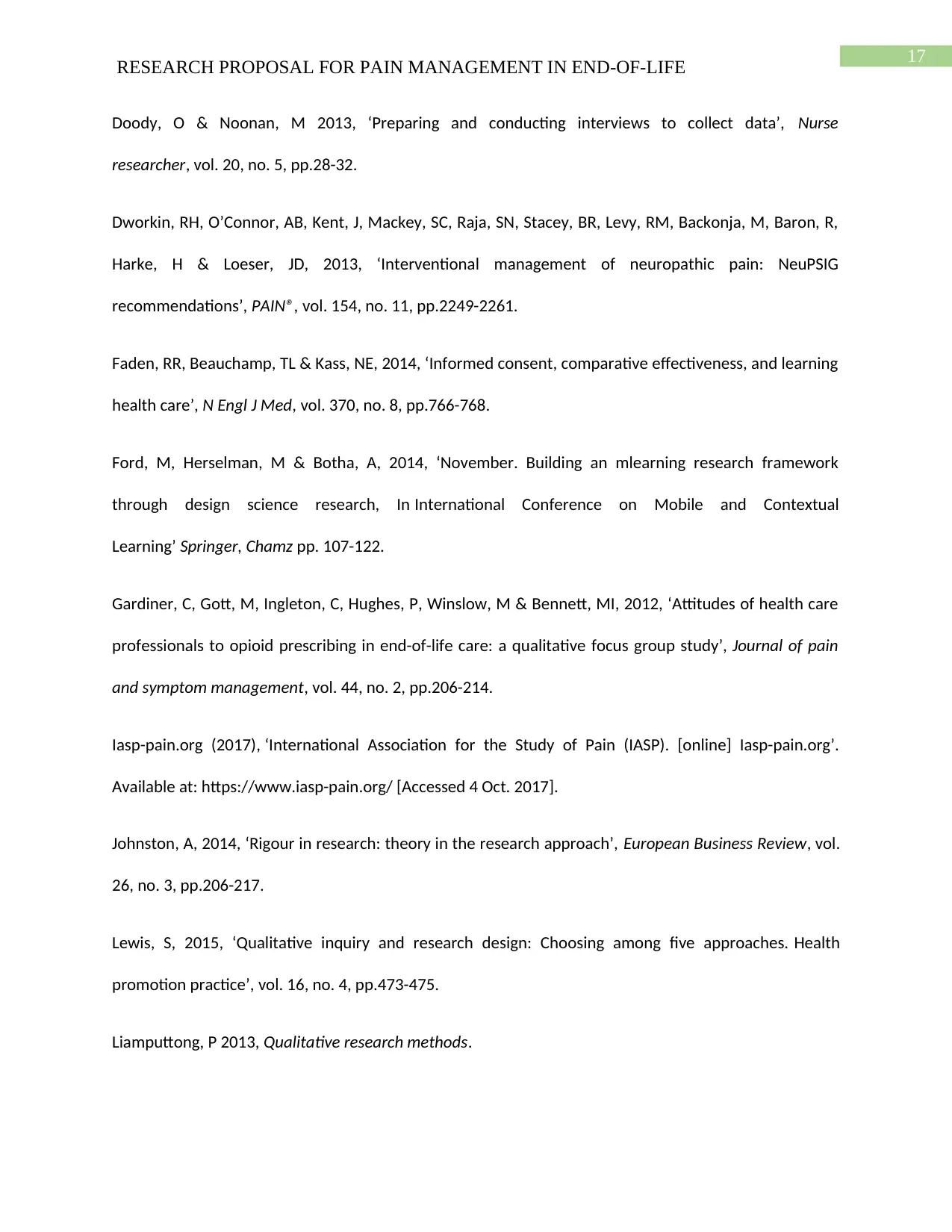
17
RESEARCH PROPOSAL FOR PAIN MANAGEMENT IN END-OF-LIFE
Doody, O & Noonan, M 2013, ‘Preparing and conducting interviews to collect data’, Nurse
researcher, vol. 20, no. 5, pp.28-32.
Dworkin, RH, O’Connor, AB, Kent, J, Mackey, SC, Raja, SN, Stacey, BR, Levy, RM, Backonja, M, Baron, R,
Harke, H & Loeser, JD, 2013, ‘Interventional management of neuropathic pain: NeuPSIG
recommendations’, PAIN®, vol. 154, no. 11, pp.2249-2261.
Faden, RR, Beauchamp, TL & Kass, NE, 2014, ‘Informed consent, comparative effectiveness, and learning
health care’, N Engl J Med, vol. 370, no. 8, pp.766-768.
Ford, M, Herselman, M & Botha, A, 2014, ‘November. Building an mlearning research framework
through design science research, In International Conference on Mobile and Contextual
Learning’ Springer, Chamz pp. 107-122.
Gardiner, C, Gott, M, Ingleton, C, Hughes, P, Winslow, M & Bennett, MI, 2012, ‘Attitudes of health care
professionals to opioid prescribing in end-of-life care: a qualitative focus group study’, Journal of pain
and symptom management, vol. 44, no. 2, pp.206-214.
Iasp-pain.org (2017), ‘International Association for the Study of Pain (IASP). [online] Iasp-pain.org’.
Available at: https://www.iasp-pain.org/ [Accessed 4 Oct. 2017].
Johnston, A, 2014, ‘Rigour in research: theory in the research approach’, European Business Review, vol.
26, no. 3, pp.206-217.
Lewis, S, 2015, ‘Qualitative inquiry and research design: Choosing among five approaches. Health
promotion practice’, vol. 16, no. 4, pp.473-475.
Liamputtong, P 2013, Qualitative research methods.
RESEARCH PROPOSAL FOR PAIN MANAGEMENT IN END-OF-LIFE
Doody, O & Noonan, M 2013, ‘Preparing and conducting interviews to collect data’, Nurse
researcher, vol. 20, no. 5, pp.28-32.
Dworkin, RH, O’Connor, AB, Kent, J, Mackey, SC, Raja, SN, Stacey, BR, Levy, RM, Backonja, M, Baron, R,
Harke, H & Loeser, JD, 2013, ‘Interventional management of neuropathic pain: NeuPSIG
recommendations’, PAIN®, vol. 154, no. 11, pp.2249-2261.
Faden, RR, Beauchamp, TL & Kass, NE, 2014, ‘Informed consent, comparative effectiveness, and learning
health care’, N Engl J Med, vol. 370, no. 8, pp.766-768.
Ford, M, Herselman, M & Botha, A, 2014, ‘November. Building an mlearning research framework
through design science research, In International Conference on Mobile and Contextual
Learning’ Springer, Chamz pp. 107-122.
Gardiner, C, Gott, M, Ingleton, C, Hughes, P, Winslow, M & Bennett, MI, 2012, ‘Attitudes of health care
professionals to opioid prescribing in end-of-life care: a qualitative focus group study’, Journal of pain
and symptom management, vol. 44, no. 2, pp.206-214.
Iasp-pain.org (2017), ‘International Association for the Study of Pain (IASP). [online] Iasp-pain.org’.
Available at: https://www.iasp-pain.org/ [Accessed 4 Oct. 2017].
Johnston, A, 2014, ‘Rigour in research: theory in the research approach’, European Business Review, vol.
26, no. 3, pp.206-217.
Lewis, S, 2015, ‘Qualitative inquiry and research design: Choosing among five approaches. Health
promotion practice’, vol. 16, no. 4, pp.473-475.
Liamputtong, P 2013, Qualitative research methods.
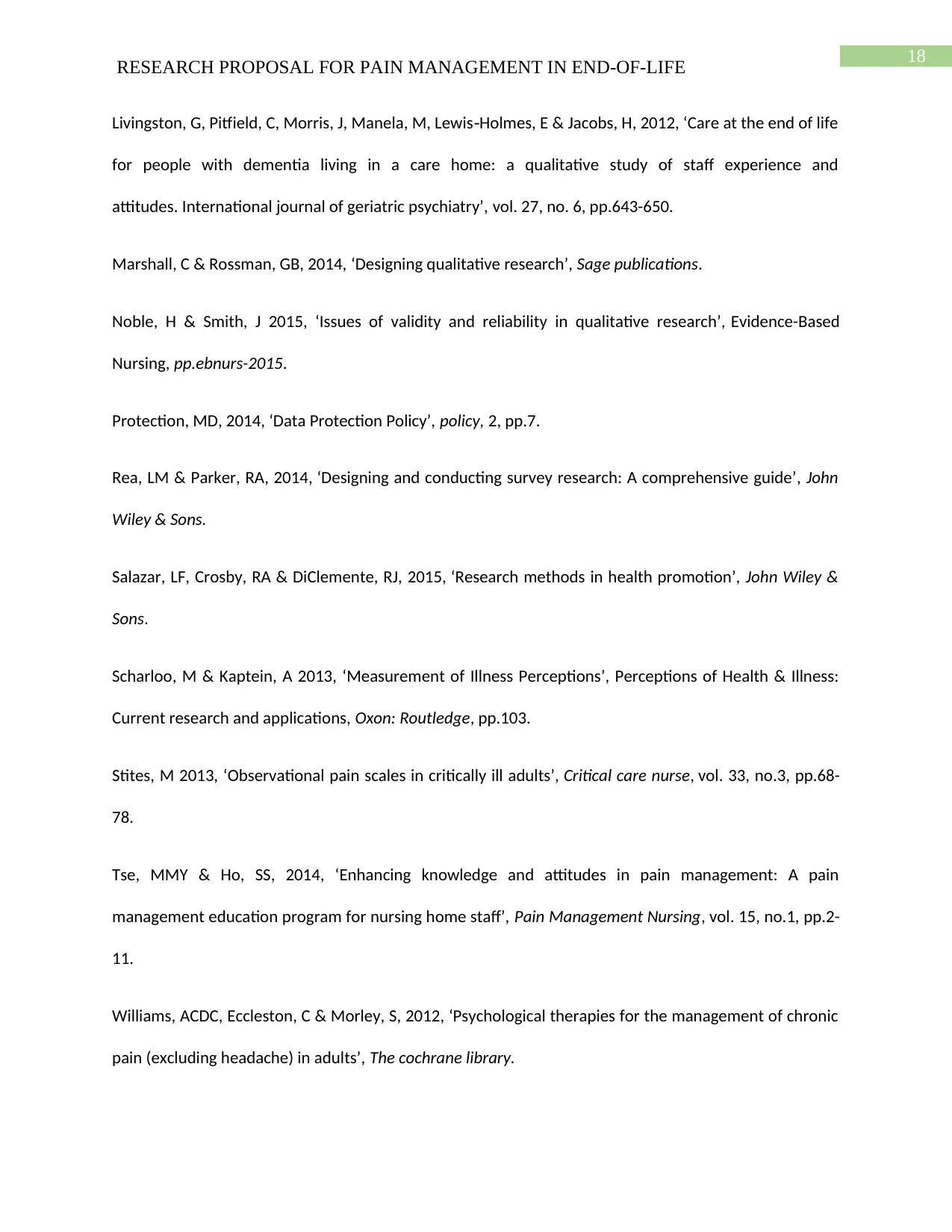
18
RESEARCH PROPOSAL FOR PAIN MANAGEMENT IN END-OF-LIFE
Livingston, G, Pitfield, C, Morris, J, Manela, M, Lewis Holmes, E & Jacobs, H, 2012, ‘Care at the end of life‐
for people with dementia living in a care home: a qualitative study of staff experience and
attitudes. International journal of geriatric psychiatry’, vol. 27, no. 6, pp.643-650.
Marshall, C & Rossman, GB, 2014, ‘Designing qualitative research’, Sage publications.
Noble, H & Smith, J 2015, ‘Issues of validity and reliability in qualitative research’, Evidence-Based
Nursing, pp.ebnurs-2015.
Protection, MD, 2014, ‘Data Protection Policy’, policy, 2, pp.7.
Rea, LM & Parker, RA, 2014, ‘Designing and conducting survey research: A comprehensive guide’, John
Wiley & Sons.
Salazar, LF, Crosby, RA & DiClemente, RJ, 2015, ‘Research methods in health promotion’, John Wiley &
Sons.
Scharloo, M & Kaptein, A 2013, ‘Measurement of Illness Perceptions’, Perceptions of Health & Illness:
Current research and applications, Oxon: Routledge, pp.103.
Stites, M 2013, ‘Observational pain scales in critically ill adults’, Critical care nurse, vol. 33, no.3, pp.68-
78.
Tse, MMY & Ho, SS, 2014, ‘Enhancing knowledge and attitudes in pain management: A pain
management education program for nursing home staff’, Pain Management Nursing, vol. 15, no.1, pp.2-
11.
Williams, ACDC, Eccleston, C & Morley, S, 2012, ‘Psychological therapies for the management of chronic
pain (excluding headache) in adults’, The cochrane library.
RESEARCH PROPOSAL FOR PAIN MANAGEMENT IN END-OF-LIFE
Livingston, G, Pitfield, C, Morris, J, Manela, M, Lewis Holmes, E & Jacobs, H, 2012, ‘Care at the end of life‐
for people with dementia living in a care home: a qualitative study of staff experience and
attitudes. International journal of geriatric psychiatry’, vol. 27, no. 6, pp.643-650.
Marshall, C & Rossman, GB, 2014, ‘Designing qualitative research’, Sage publications.
Noble, H & Smith, J 2015, ‘Issues of validity and reliability in qualitative research’, Evidence-Based
Nursing, pp.ebnurs-2015.
Protection, MD, 2014, ‘Data Protection Policy’, policy, 2, pp.7.
Rea, LM & Parker, RA, 2014, ‘Designing and conducting survey research: A comprehensive guide’, John
Wiley & Sons.
Salazar, LF, Crosby, RA & DiClemente, RJ, 2015, ‘Research methods in health promotion’, John Wiley &
Sons.
Scharloo, M & Kaptein, A 2013, ‘Measurement of Illness Perceptions’, Perceptions of Health & Illness:
Current research and applications, Oxon: Routledge, pp.103.
Stites, M 2013, ‘Observational pain scales in critically ill adults’, Critical care nurse, vol. 33, no.3, pp.68-
78.
Tse, MMY & Ho, SS, 2014, ‘Enhancing knowledge and attitudes in pain management: A pain
management education program for nursing home staff’, Pain Management Nursing, vol. 15, no.1, pp.2-
11.
Williams, ACDC, Eccleston, C & Morley, S, 2012, ‘Psychological therapies for the management of chronic
pain (excluding headache) in adults’, The cochrane library.
Paraphrase This Document
Need a fresh take? Get an instant paraphrase of this document with our AI Paraphraser

19
RESEARCH PROPOSAL FOR PAIN MANAGEMENT IN END-OF-LIFE
Zamawe, FC 2015, ‘The implication of using NVivo software in qualitative data analysis: Evidence-based
reflections’, Malawi Medical Journal, vol. 27, no. 1, pp.13-15.
RESEARCH PROPOSAL FOR PAIN MANAGEMENT IN END-OF-LIFE
Zamawe, FC 2015, ‘The implication of using NVivo software in qualitative data analysis: Evidence-based
reflections’, Malawi Medical Journal, vol. 27, no. 1, pp.13-15.
1 out of 20
Related Documents
Your All-in-One AI-Powered Toolkit for Academic Success.
+13062052269
info@desklib.com
Available 24*7 on WhatsApp / Email
![[object Object]](/_next/static/media/star-bottom.7253800d.svg)
Unlock your academic potential
© 2024 | Zucol Services PVT LTD | All rights reserved.





